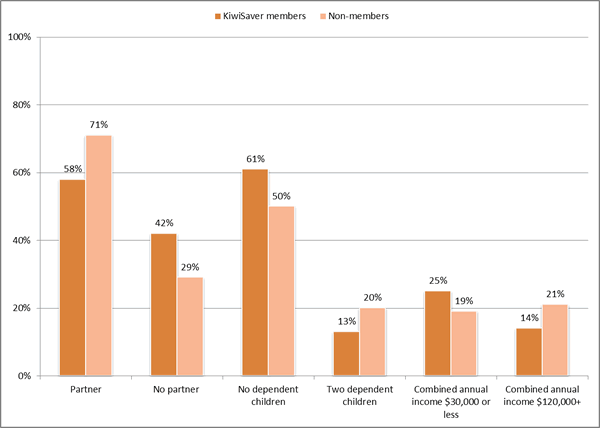Indicator 11: Income security
| Indicator is fully reported? |
Yes. KiwiSaver evaluation reports also publish information about uptake of the scheme by income distribution and other factors. |
| Type of indicator |  Outcome indicator Outcome indicator |
| Other relevant indicators | NA |
| Our findings |
Public income security programmes are important for reducing the risk of poverty and/or material hardship in older age. There are:
Older people might also have private income and savings; income from these sources is not the focus of this indicator. About the pension All people who meet certain age and residency requirements are eligible to apply for the pension. The pension is available from age 65 and is funded from general government revenue. The Veteran’s Pension is an alternative pension available to eligible people from age 65. Our report on indicator 21 sets out more information about the pensions. Uptake of the pension The Ministry of Social Development (MSD) reports on the proportion of people receiving the pension in its annual statistical report. The latest report said that, between 2007 and 2011, the proportion of people aged 65+ who were receiving the pension increased from an estimated 92.8% to 95% of the total population aged 65+.[1] The main reason that people aged 65+ do not receive a pension is because they do not meet the residential criteria for eligibility.[2] In March 2012, MSD released a brochure (Services for Seniors[3]) to tell older people about their entitlements. It is available from MSD, Work and Income Service Centres, other agencies (such as libraries), and non-government organisations (NGOs).[4] About KiwiSaver The KiwiSaver Act 2006 introduced a voluntary savings scheme to encourage long-term savings habits and asset accumulation to increase individuals’ well-being and financial independence, particularly in retirement. Any eligible person under the age of 65 years can enrol in KiwiSaver.[5] Uptake of KiwiSaver by older people Because it is relatively new, KiwiSaver will have a greater role in increasing the assets and income of people who are currently under 60 years old than it will for people who are over 60. Data has been published on older people’s enrolment in KiwiSaver. Inland Revenue publishes a KiwiSaver evaluation report each year. At 30 June 2012, the:
Data on the proportion of eligible members by income distribution in $10,000 bands was also reported.[9] There were slightly lower proportions of KiwiSaver members in low income levels (up to $20,000) than in the eligible population. Inland Revenue does not hold ethnicity data about KiwiSaver members. Information gained through a survey found that KiwiSaver members were broadly similar to non-members across several demographics, such as age, gender, and ethnicity. There were some statistically significant differences (see Figure 1).[10] |
| How entities use the data |
MSD is responsible for improving access to entitlements, including the pension. When someone is nearing their 65th birthday, Inland Revenue sends them a letter telling the person to contact MSD (Senior Services) and make arrangements to receive their pension when they turn 65. Inland Revenue sends these letters because MSD does not have the necessary taxpayer information. Information about pension eligibility and how to apply for it is widely available in places such as libraries, on government agencies’ websites and in their offices, medical centres, and from NGOs. Inland Revenue uses data about KiwiSaver members and non-members to understand their characteristics, saving rates, and related behaviours. It publishes annual reports as part of the KiwiSaver evaluation to summarise trends, performance data, and the results of relevant research and analysis. These reports and the cross-government KiwiSaver evaluation work programme support policy development, the management of service delivery, and wider research and discussion about retirement income provision. For example, for those people on low salaries or wages, the 2% deduction might be affecting their standard of living if that money is required for basic essentials. It could be argued that this group of people would be better using the 2% now and relying on the pension (which could be worth more than their current income) in retirement.[11] |
| Entity responsible for this indicator | Inland Revenue – KiwiSaver Ministry of Social Development – New Zealand Superannuation Veterans' Affairs of New Zealand – Veteran's Pension |
Figure 1: Statistically significant differences between KiwiSaver members and non-members, 2010

Graph derived from data reported by Colmar Brunton (2010), KiwiSaver Evaluation: Survey of Individuals Summary Report, page 30, www.ird.govt.nz/aboutir/reports/research/report-ks/ks-evaluation-summary-report.html.
[1] Ministry of Social Development (2012), The Statistical Report for the year ending June 2011, pages 171, www.msd.govt.nz/about-msd-and-our-work/publications-resources/statistics/statistical-report/statistical-report-2011.html. In between censuses, Statistics New Zealand produces population reports that estimate the population at different dates. MSD uses these estimates to calculate the estimated percentage uptake of the pension.
[2] Other reasons could be that they are receiving income from an overseas pension, private sources, or other government sources, such as ACC weekly compensation, the domestic purposes benefit, or the invalids benefit. Or, they might not know about the pension.
[3] www.msd.govt.nz/about-msd-and-our-work/publications-resources/brochures/services-for-seniors.html.
[4] Ministry of Social Development Annual Report 2011/12, page 24, www.msd.govt.nz/about-msd-and-our-work/publications-resources/corporate/annual-report/.
[5] The applicant has to be a New Zealand citizen or be entitled to live in the country indefinitely and be living in the country. More information about the scheme is available from www.kiwisaver.govt.nz/.
[6] Inland Revenue (2012), KiwiSaver Annual Report July 2011 to June 2012, Figure 3, page 10, www.ird.govt.nz/aboutir/reports/research/report-ks/research-ks-annual-report-2012.html.
[7] Inland Revenue (2012), KiwiSaver Annual Report July 2011 to June 2012, Figure 4, page 10, www.ird.govt.nz/aboutir/reports/research/report-ks/research-ks-annual-report-2012.html.
[8] Inland Revenue (2012), KiwiSaver Annual Report July 2011 to June 2012, page 9, www.ird.govt.nz/aboutir/reports/research/report-ks/research-ks-annual-report-2012.html.
[9] Inland Revenue (2012), KiwiSaver Annual Report July 2011 to June 2012, page 10 and Figure 5, page 11, www.ird.govt.nz/aboutir/reports/research/report-ks/research-ks-annual-report-2012.html.
[10] Colmar Brunton (2010), KiwiSaver Evaluation: Survey of Individuals Final Report, page 30, www.ird.govt.nz/aboutir/reports/research/report-ks/ks-evaluation-summary-report.html.
[11] See Inland Revenue (2010), KiwiSaver Evaluation Survey of Individuals Summary Report, page 23, www.ird.govt.nz/aboutir/reports/research/report-ks/ks-evaluation-summary-report.html; and New Zealand Treasury (2010), Healthy, Wealthy and Working: Retirement Decisions of Older New Zealanders, working paper 10/02, page 65, www.treasury.govt.nz/publications/research-policy/wp/2010/10-02/twp10-02.pdf. The minimum deduction increased to 3% on 1 April 2013.

